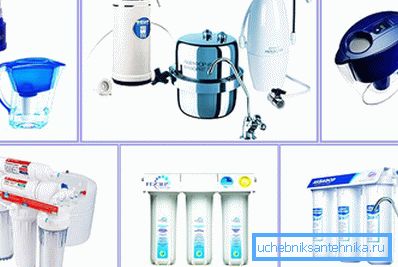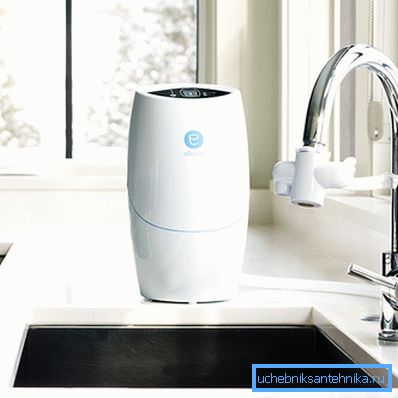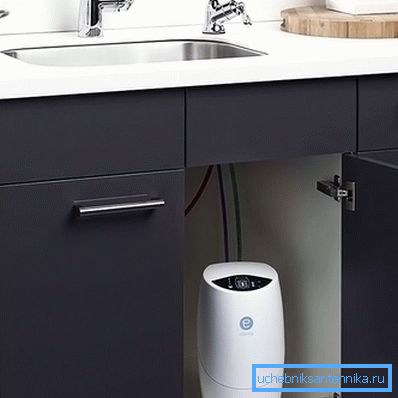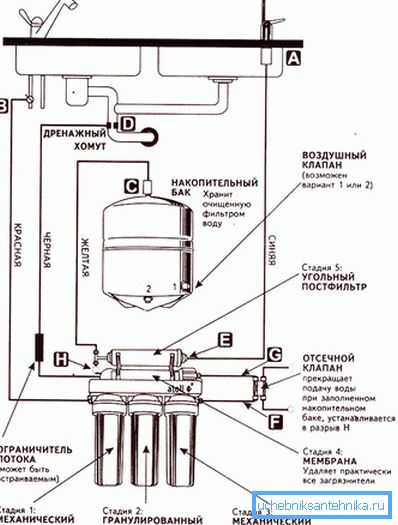How to choose a filter for water purification
Man is 80% water. Therefore, it is very important that the fluid we consume be of high quality. According to the World Health Organization, most of the diseases are caused by the fact that the water consumed by man is of poor quality. It may contain harmful components and various impurities. Such water, among other things, can spoil the instruments used in its operation. For example, on a water heating boiler or a washing machine, scale will often collect, which leads to wear of parts. Therefore, if you want to protect your health, and also to keep household appliances in good condition, you should consider buying a water filter. This will not only help you improve your health, but also save you from the cost of medicines and household appliances. There are a lot of such filters on the market, so in this article we will look at how to choose a filter for water purification.
Classification

Filters differ in the method of installation and characteristics. If you are faced with a choice, you first need to decide which one is right for you. Should take into account personal needs and properly combine them with the material capabilities. Filters are divided into the following types:
- jug type;
- nozzles on the crane;
- flow filters for washing;
- flow filters for washing;
- reverse osmosis systems.
Let's take a detailed look at their features and differences, as well as find out their advantages and disadvantages. After analyzing all the data, you can decide which one to choose.
Jug type filters

Such devices are the most primitive. Often this is a regular jug, similar to a kettle, inside of which filter cartridges are located. Water is poured into it and within a few minutes it is filtered. The resource of such cartridges is small - 300 liters of water per 1 cartridge. The main purpose is to remove chlorine and odors from water. Partially they make the water softer. Such jugs are portable and compact. Their use is possible both at home and on the road or any other place. You will always be provided with clean water. Replacement cartridges need to be done once a month with frequent use.
Benefits:
- Easy to use.
- Portable.
- Connection to the water supply is not required.
- No need for human control.
- Affordable price.
Disadvantages:
- Low degree of cleaning (as opposed to filters built into the water supply).
- A small amount of purified water.
- Frequent cartridge replacement.
The volume of liquid filtered at a time does not exceed the volume of the jug itself, which often amounts to 1–2 liters of water. It turns out, if you need 3 liters of water for cooking, you will have to fill the jug several times. Agree, it is not very convenient.
Filter jugs - ideal for the kitchen, where there is not enough space to install a stationary system. Moreover, if your budget is limited, you can afford a portable filter that is always at hand.
Nozzles on the crane

The name itself suggests that they are mounted directly on the crane. Such nozzles are very small and compact. Principle of action: under pressure, water passes through a nozzle, inside of which there is a filter element. As a result, the water is purified, and the amount you need will always be available. They are divided into two types:
- stationary nozzle;
- removable nozzle.
Stationary nozzle is always on the tap. It has two modes - “with cleaning” and “without cleaning”, which can be switched, depending on the needs. Removable nozzles are put on the faucet when you need to filter the water. If you do not need it, you need to remove the nozzle. Special water cartridges are cleaned with water containing activated carbon and other components. Due to this composition, chlorine, impurities and unpleasant odors are removed from the water. There are also cartridges that can make hard water softer.
Benefits:
- Compact.
- Easy to install.
- Economical.
Disadvantages:
- Low sorbent volume.
- Poor performance (0.5 liters per minute).
- The need for storage tanks for filtered liquid.
- Reduces pressure in the water supply system.
- Low degree of water purification.
Some manufacturers claim that the performance may be higher than 0.5 liters per minute, but customer reviews suggest that they are often exaggerated.
Filters for washing

They are not installed on the faucet itself, but near at the sink. The flexible hose from the device is attached to the faucet.
Benefits:
- High performance (up to 1.5 liters per minute).
- Sufficient water purification.
- No need for separate water tanks.
Disadvantages:
- Manual connection and disconnection after filtering.
- Takes place on the working surface.
Filters under the sink

This stationary filter is installed under the sink and is connected to the water supply. There are no additional hoses. Change cartridges should be carried out after six months of use. The highest degree of purification is 0.05–1 microns.
Benefits:
- High performance.
- Great resource of purified water.
- Simple cartridge change.
- High degree of water purification.
- Convenient location.
Disadvantages:
- High price.
- Does not cope with some viruses and bacteria.
Such filters are 2-and 3-step. 2-step consist of two flasks with a filter for cleaning the first and second degree with the help of activated carbon. In the 3-stage filters there is an ion exchange resin, which provides the third stage of purification.
Reverse Osmosis Systems

Today, these are the best filters that bring water to near-perfect purification. Thanks to these filters, not only water hardness is removed, but also chlorine, iron, and more importantly, viruses and bacteria. The main filtering component is the reverse osmosis membrane. The pores of the membrane are so small that viruses and bacteria known to humans cannot pass through them. Therefore, there should be no cause for concern about health.
The membrane cleans itself with a small amount of filtered water, and all the dirt, viruses and bacteria go down the drain. Thus, you can get at home a liquid that is not inferior in quality to distilled water.
Cleaning steps:
- Stage 1 - a cartridge that consists of polypropylene purifies water from mechanical impurities (15–30 µm);
- Stage 2 - a cartridge with activated carbon that cleans the liquid from chlorine, gases and organochlorine compounds;
- Stage 3 - thorough cleaning of impurities (1–5 microns) or cleaning with pressed coal, which increases the service life of the membrane;
- Stage 4 - cleaning the reverse osmosis membrane;
- Step 5 - post filter from coal.
But with such water should be careful not to abuse it. Reverse osmosis cleaning system makes water dead. It lacks the minerals and salts that the body needs. With frequent use of this water, leaching of calcium, fluorine and other useful substances occurs.
Benefits:
- Maximum degree of purification.
- Ease of use.
- Removal of viruses and bacteria.
- Permanent supply of water.
- Replace the cartridge membrane every 3 years, post cleaners - once a year.
Disadvantages:
- High price.
- Large size.
- Part of the filtered water goes down the drain, increasing the flow of water. At 1 liter of pure water, 6 liters of normal is consumed.
- The water becomes dead.
There are special mineralizers that complement such a system. They fill the purified water with all the necessary minerals that improve digestion, blood circulation and body functions.
Requirements for filtration systems

It is very important that the filter is made of safe and environmentally friendly materials. After all, it is designed for water purification, so it should not emit odor and contain chemicals.
In order to protect yourself and extend the life of any filter, you must replace the cartridges on time. Then the quality of cleaning will always be at the proper level.
The case of stationary filters must be strong and durable. Modern filters are made of glass-filled plastic, which is stronger and better than ordinary.
Having compared all the facts, having considered the disadvantages and advantages of different types of water filtration systems, you can decide which one to choose. The main thing is to be guided by common sense. Do not think that the jug will serve you for 10 years. Consider how many family members you have. If you are single, you will need only a tap or a jug. And in the case when you have a large family, the stationary system is the ideal solution.
Video
Video review of water filters: